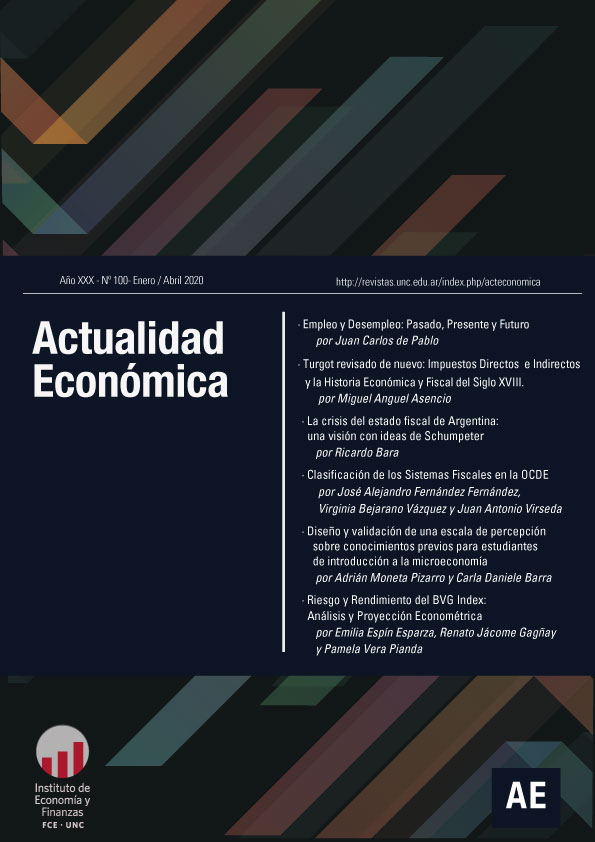Turgot revised again: Direct and Indirect Taxes and the Economic and Fiscal History of the 18th Century
Keywords:
Direct Taxation, Indirect Taxation, Tax HistoryAbstract
The paper explore some issues related to direct and indirect taxation and the origin of the dichotomy in the Century preceding the Revolutionary France, mainly for the approach to taxation of the physiocrats. In particular, it is examined the contribution of Turgot and its approach to the classification of tributes in the context of France in the second half the XVIII Century. The conclusion adress the ubication of such contribution, the influences received and the notions assumed given his overview of direct and indirect taxation, as a precedent of modern or contemporary treatments.
Downloads
References
Alberdi, J. B. (1856). Sistema económico y rentístico de la Confederación Argentina, Ediciones de la Libertad, Buenos Aires.
Asensio, M. A. (2013). "Turgot y Hamilton en la economía del federalismo". Anales de la AAEP , Argentina.
Asensio, M. A (2015a). Finanzas Públicas. Notas de Orientación, Buyatti, Buenos Aires.
Asensio, M. A (2015b). Economía Fiscal. Presupuesto y finanzas estatales, Buyatti, Buenos Aires.
Atkinson, A. (1977): “Optimal Taxation and the Direct versus Indirect Tax Controversy”, The Canadian Journal of Economics/Revue canadienne d’ Economique, 10 (4), 590-606.
Bodin, J. (2010). Los seis libros de la República, Colección Clásicos del Pensamiento, Tecnos, Madrid (original de 1579).
Bullock, C. (1898). "Direct and Indirect Taxation in Economic Literature", Political Science Quarterly, Volume 13, N° 3, September.
De la Nuez, P. (2009). “Introducción”, en Turgot, A. R. J. Reflexiones sobre la formación y distribución de las riquezas. Elogio de Gournay, Unión Editorial, Madrid.
Ferguson, N. (2001). Dinero y poder en el mundo contemporáneo, 1700-2000, Taurus, Barcelona.
Grimal, P. (2008). La civilización romana. Vida, costumbres, artes, leyes. Bolsillo Paidós, Editorial Paidós, Buenos Aires.
Groenewegen, P. (2015). Eighteenth-century Economics. Turgot, Beccaria and Smith and their contemporaries, Routledge Studies in the History of Economics, Routledge, Nueva York.
Higgs, H. (1933). La fisiocracia, FCE, México.
Higgs, H. (1984). "Finance", in Ward, Prothero and Leathes, Volume VIII of The Cambridge Modern History, The French Revolution, p. 66-78.
Hinrichs. H. (1967). La estructura tributaria durante el desarrollo, CEMLA.
Meek, R. (1976). Los fisiócratas, Editorial Ariel, Madrid.
Mill, J. S (1978). Principios de Economía Política, FCE (edición original de 1848, con otras posteriores, siendo la de 1871 la última corregida por Mill).
Montague, F. C. (1934). "Louis XVI", Chapter IV of Cambridge Modern History, op. cit., pp. 79-118.
Musgrave, R. A. (1972). Sistemas Fiscales, Aguilar, Madrid.
Rothbard, M. (2009). “La brillantez de Turgot”, en Turgot, A. R. J.. Reflexiones sobre la formación y distribución de las riquezas, Elogio de Gournay (2009) (hay también Edición del Mises Institute y otros).
Say, J. B. (2001). Tratado de Economía Política, FCE, México (original de 1841).
Schumpeter, J. A. (2014). Historia del análisis económico, Ariel, Madrid.
Turgot, A. R. J. (2011). Turgot Collection, Liberty Fund, Ludwig Von Mises Institute. (original publicado en 1767).
Turgot, A. R. J. (2009). Reflexiones sobre la formación y distribución de las riquezas. Elogio de Gournay, Unión Editorial, Madrid (original publicado en 1759)
Turgot, A. R. J. (1763). "Paper on Taxation in General, on Land Taxes in Particular, and on a Project of a Land Register", incluido como Capítulo 9 en Turgot Collection, op. cit.
Vaggi, G. y Groenewegen P. (2014). A Concise History of Economic Thought. From Mercantiism to Monetarism, Palgrave MacMillan, Hampshire.
Downloads
Published
Issue
Section
License

This work is licensed under a Creative Commons Attribution-NonCommercial-NoDerivatives 4.0 International License.
Those authors who have published with this journal, accept the following terms:
Authors will conserve their copyright and guarantee the magazine the right of first publication of their work, which will be simultaneously subject to the Creative Commons Attribution-NonCommercial-NoDerivative 4.0 International License that allows third parties to share the work as long as the author and first publication of this magazine are indicated.
Authors may adopt other non-exclusive license agreements to distribute the published version of the work (e.g., deposit it in an institutional telematic archive or publish it in a monographic volume) provided that the initial publication in this journal is indicated.
Authors are allowed and encouraged to disseminate their work through the Internet (e.g., in institutional telematic archives or on their website) before and during the submission process, which may lead to interesting exchanges and increase citations of the published work. (See The effect of open access)









